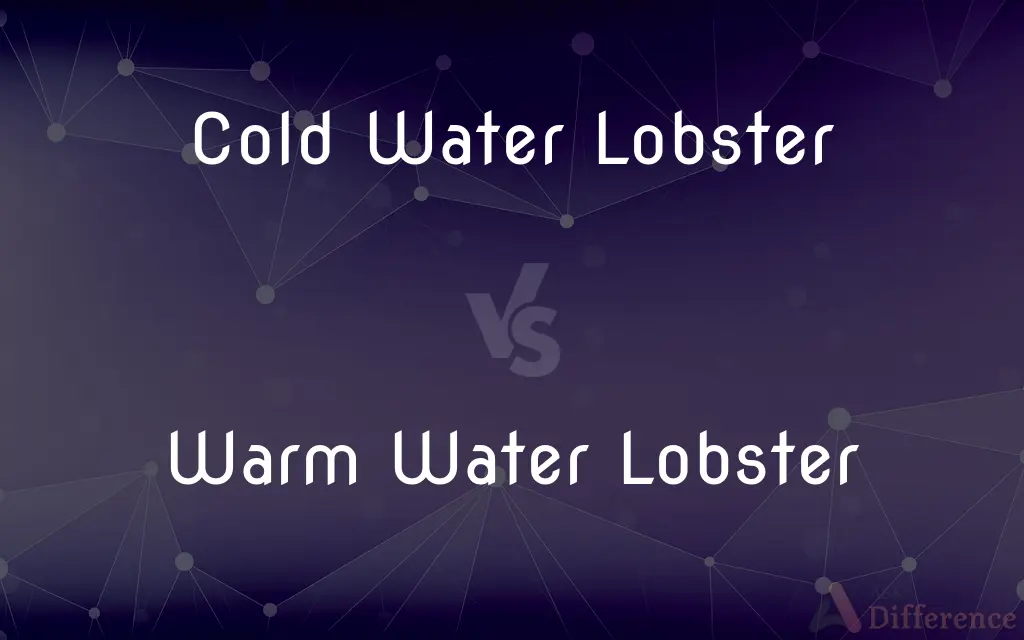Cold Water Lobster vs. Warm Water Lobster — What's the Difference?
By Tayyaba Rehman & Urooj Arif — Published on December 11, 2024
Cold water lobsters, known for their tender, sweet meat, primarily come from the Atlantic, while warm water lobsters, found in tropical waters, have firmer, less flavorful meat but larger claws.

Difference Between Cold Water Lobster and Warm Water Lobster
Table of Contents
ADVERTISEMENT
Key Differences
Cold water lobsters, typically from the North Atlantic, are prized for their delicate, sweet flavor and tender texture, particularly noted in their tail meat. These lobsters, often referred to as Maine lobsters, have a hard shell which contributes to the quality of their meat. They are a popular choice in fine dining and are considered more premium compared to their warm water counterparts.
Warm water lobsters, on the other hand, are found in the warmer climates of the Caribbean, Latin America, and parts of Asia and Africa. They tend to have a firmer texture and a milder flavor than cold water lobsters. One distinct feature of warm water lobsters is that they usually have larger claws, which provide a substantial amount of meat. However, their shell is softer, which can sometimes affect the texture of the meat during cooking.
The environment plays a significant role in the differences between these two types of lobster. Cold water lobsters thrive in the colder, nutrient-rich waters of the Atlantic, which contributes to their sweeter taste and tender texture. Warm water lobsters adapt to warmer, tropical waters, which influences their firmer meat and milder flavor.
In terms of culinary use, cold water lobster is often the preferred choice for dishes that highlight the natural flavor and texture of the lobster meat, such as steamed or boiled lobster dishes. Warm water lobster, while still delicious, is more commonly used in dishes where the lobster is mixed with other strong flavors or sauces.
When it comes to pricing and availability, cold water lobsters are generally more expensive due to their highly regarded meat quality and the more challenging fishing conditions in colder waters. Warm water lobsters are more widely available and often more affordable, making them a popular choice in a variety of culinary settings.
ADVERTISEMENT
Comparison Chart
Habitat
North Atlantic, cold waters
Caribbean, Latin America, warm waters
Meat Quality
Tender, sweet
Firmer, less flavorful
Shell
Hard
Softer
Flavor
Delicate, sweet
Milder
Claw Size
Smaller
Larger
Preferred Culinary Use
Steamed, boiled to highlight natural flavor
Used in flavored or sauced dishes
Price
Generally higher
More affordable
Availability
Less widely available, seasonal
Widely available
Compare with Definitions
Cold Water Lobster
Often served in dishes that highlight its natural flavor.
A simple butter sauce was all that was needed to complement the cold water lobster's natural taste.
Warm Water Lobster
Found in the warmer waters of the Caribbean and Latin America, with firmer meat.
The warm water lobster had a firmer texture, making it ideal for the chef's signature grilled dish.
Cold Water Lobster
A type of lobster found in the cold waters of the North Atlantic, known for its sweet, tender meat.
The restaurant's menu featured a cold water lobster dish that was steamed to perfection.
Warm Water Lobster
More affordable and widely available.
Warm water lobster was a popular choice on the menu, known for its accessibility and lower price.
Cold Water Lobster
Prized for its premium quality and delicate flavor.
Gourmets often prefer cold water lobster for its unparalleled sweetness and tender texture.
Warm Water Lobster
Known for its larger claws, providing substantial meat.
The warm water lobster's large claws were a highlight of the seafood platter.
Cold Water Lobster
Typically has a hard shell that protects its quality during cooking.
The hard shell of the cold water lobster ensures its meat remains tender during boiling.
Warm Water Lobster
More commonly used in dishes with strong flavors or sauces.
The warm water lobster was served in a spicy curry that enhanced its milder flavor.
Cold Water Lobster
Considered more luxurious and is priced higher.
Due to its exquisite taste, cold water lobster is often more expensive than its warm water counterpart.
Warm Water Lobster
Has a softer shell, which can affect meat texture during cooking.
The chef took extra care when cooking the warm water lobster due to its softer shell.
Common Curiosities
Can you eat the claws of a warm water lobster?
Yes, warm water lobsters have larger claws compared to cold water lobsters, and the meat from these claws can be consumed and enjoyed.
Is there a significant price difference between cold water and warm water lobster?
Yes, cold water lobster is generally more expensive due to its premium meat quality and the more challenging fishing conditions in colder waters.
Is cold water lobster available year-round?
Cold water lobster availability can be seasonal, and it is generally less widely available compared to warm water lobster.
Are there any sustainability concerns with lobster fishing?
Sustainability practices vary by region and fishery; it's important to source lobster from suppliers who adhere to responsible fishing practices to ensure the long-term health of lobster populations.
Can warm water lobster be used in traditional lobster dishes?
Yes, warm water lobster can be used in traditional dishes, but adjustments may be needed to account for its firmer texture and milder flavor.
How should lobster be stored before cooking?
Live lobsters should be kept in a cool, moist environment, such as the refrigerator, and cooked as soon as possible to maintain freshness.
Why is cold water lobster considered better than warm water lobster?
Cold water lobster is often considered superior due to its sweet, tender meat and delicate flavor, making it a preferred choice for dishes that showcase the lobster's natural taste.
Are there any cooking methods that are better suited for warm water lobster?
Warm water lobster is often used in dishes with stronger flavors or sauces, as its firmer meat and milder taste complement a variety of culinary styles.
Is there a nutritional difference between cold water and warm water lobster?
The nutritional content is similar, but slight variations may occur due to differences in diet and environment; both are good sources of protein and nutrients.
Can the flavor of a lobster be influenced by its habitat?
Yes, the environment, including water temperature and the lobster's diet, can significantly influence the flavor and texture of the lobster meat.
Share Your Discovery

Previous Comparison
Hostname vs. Domain NameAuthor Spotlight
Written by
Tayyaba RehmanTayyaba Rehman is a distinguished writer, currently serving as a primary contributor to askdifference.com. As a researcher in semantics and etymology, Tayyaba's passion for the complexity of languages and their distinctions has found a perfect home on the platform. Tayyaba delves into the intricacies of language, distinguishing between commonly confused words and phrases, thereby providing clarity for readers worldwide.
Co-written by
Urooj ArifUrooj is a skilled content writer at Ask Difference, known for her exceptional ability to simplify complex topics into engaging and informative content. With a passion for research and a flair for clear, concise writing, she consistently delivers articles that resonate with our diverse audience.












































